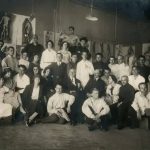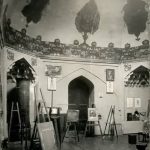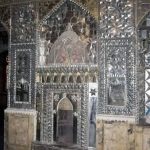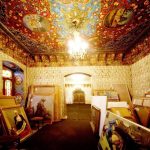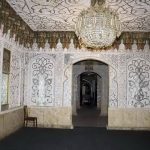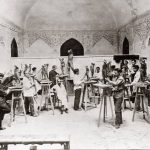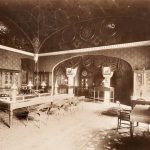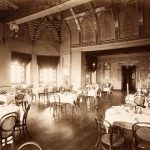Historic Building
Dating from the 1850s, the Tbilisi State Academy of Art building is one of the most outstanding heritage sites in Tbilisi. Defined by an eclectic mix of European and oriental architectural and artistic styles, this landmark building is best known for the so-called Mirror Halls, the sumptuous adornment of which, executed by Qajar artists invited from Iran, are reminiscent of the decoration of oriental palaces.
Before the Foundation
The foundation of the Academy was preceded by intensive activities in the field of arts. In 1874, the Artists’ Society founded the first elementary school of arts. Later, in 1901, a secondary school of painting and sculpture was opened, which functioned under the patronage of the Saint Petersburg Imperial Academy of Arts. Before 1921 private arts schools functioned in Tbilisi and other towns of Georgia. In late 1921 the so-called ‘high arts workshops’ were established, and in the beginning of 1922, the People’s Studio was founded by the renowned Georgian artist Mose Toidze.
However the idea of establishing a higher educational institution was ripe among Georgian artistic circles, who saw it as the only way towards the improvement of the quality of arts education. Founded in 1916 by the celebrated Georgian artist Dimitri Shevardnadze, the Society of Georgian Artists made every endeavour to achieve the goal. Their efforts culminated with the foundation of the Academy in 1922.
Foundation of the Academy
The Georgian Academy of Fine Arts, as it was called originally, was founded on 8 March, 1922 by the decree of the People’s Commissariat for Education. It was the first higher educational institution specializing in arts in Georgia and the Caucasus and one of the three academies, along with those of Leningrad and Riga, in the former Soviet Union.
Originally the Academy had four faculties, those of Painting, Sculpture, Graphic Arts and Architecture. Later, in 1925, the Ceramic School of the Academy was transformed into a Ceramic Workshop, while in autumn 1927, a Department of Ceramic Art was created at the Faculty of Sculpture.
From 22 April 1922 the Academy was managed by the Board of Professors represented by Gigo Gabashvili, Iakob Nikoladze, Eugene Lanceray, Joseph Charlemagne, Yeghishe Tatevosyan, Henryk Hryniewski, Anatoly Kalgin and Nicholas Severov. Giorgi Chubinashvili, founder of the Georgian art history school, was elected first rector of the Academy at the meeting of the Professors’ Board on 14 May 1922. During 1922-1923 the Academy had 156 students, the number of which increased to 270 during 1946-1947; in 1973 there were 848 students at the four faculties and 204 professors. At present, 327 professors teach 1380 students.
The Academy underwent a series of reforms beginning from 1930. In 1929-30 it was first reorganised into a Higher Art and Technical Institute of industrial profile.The faculties of Architecture, Painting and Sculpture, Ceramics and Lithography were created. In 1931 the Institute was closed and in summer of the same year it was abolished. Instead, a Faculty of Fine Arts was set up within the Tbilisi Pedagogical Institute that lacked the human resources and logistics needed for arts education. The Faculty of Architecture was incorporated into the Institute of Construction. On 1 February, 1933 the Academy was restored and called the Tbilisi State Academy of Art.
The faculties of Painting, Graphic Art, Sculpture and Ceramic were restored, yet the Faculty of Architecture was not reinstateduntil 1937. David Kakabadze became Head of the Chair of Painting, Iakob Nikoladze of the Chair of Sculpture, Mose Toidze of the Chair of Drawing, Alexander Pitskhelauri of the Chair of Ceramics, and Shalva Amiranashvili of the History of Art. The Academy was later joined by former graduates of the Academy, namely Giorgi Sesiashvili, Apolon Kutateladze, Lado Grigolia, Simon Nadareishvili, Korneli Sanadze, Silovan Kakabadze, Konstantine Merabishvili, et al. From 1933 annual exhibitions of students’ works were held.
In 1943, a Painting Chair was founded with Sergo Kobuladze becoming the first head. In 1947, a drama workshop was set up on the initiative of Davit Kakabadze, who became its first head (later the workshop was led by the renowned stage designer Parnaoz Lapiashvili). The late 1940s and the beginning of the 1950s were characterised by a growing pressure on the creative freedom of artists. Davit Kakabadze was dismissed from the Academy and towards the end of the 1950s and in the beginning of the 1960s a new generation of teaching artists joined the Academy. Thanks to its cooperation with talented artists, the school retained high level and prestige. At the end of the 1950s the Academy faced a threat of abolition because of the plans of the Soviet government to modernize the educational sector in the USSR. The then Rector, Professor Apolon Kutateladze tried his best to avoid the closure of the Academy. He visited Moscow several times to gain support among the highest authorities, which he managed to achieve and the Academy continued its existence.
In the same period efforts were made to advance applied arts. In 1959, the departments of Textile and Costume Design, Woodwork and Metalwork and of Industrial Art were set up, while in 1961 the Department of Plastic Decoration was established. The same year, the DecorativeApplied Arts Faculty was created in every field of applied arts. In 1966, the Department of Restoration was opened, which was transformed into a faculty in 2004. In 1967, thanks to the efforts of Levan Rcheulishvili and the support of Vakhtang Beridze and his colleagues, a Faculty of Art History and Theory was founded, which had its first graduates in 1972. In 2005 the Faculty of Restoration was united with the Faculty of Art History and Theory. The same year the Media Faculty was founded to which the Institute of Photography was joined in 2006. Today the Academy unites five faculties: those of Fine Arts, Architecture, Design, Media Art, Restoration/Art History and Theory.
Rectors
G. Chubinashvili (1922-26)
A. Duduchava (1927-30)
V. Kotetishvili (1930-32)
G. Bukhnikashvili (1933-36)
S. Kakabadze (1936-42)
U. Jafaridze (1942-48)
M. Duduchava (1948-52)
S. Kobuladze (1952-59)
A. Kutateladze (1959-72)
G. Totibadze (1972-82)
Z. Nijaradze (1982-87)
T. Peradze (1987-92)
S. Koiava (1992-2003)
G. Bugadze (2003-2012)
N. Gaganidze (2012)
T. Varvaridze (2012)
I. Popiashvili (2012)
T. Kldiashvili (2012 November – 2014)
G. Gugushvili (2014-2022)
K. Kutateladze (2022 – up to now)





